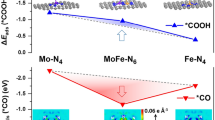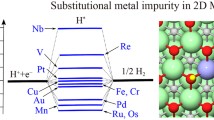Abstract
Fluorescence yield near-edge spectroscopy (FYNES) above the carbon K edge and temperature programmed reaction spectroscopy (TPRS) have been used as the methods for characterizing the reactivity and structure of adsorbed aniline and aniline derived species on the Ni(100) and Ni(111) surfaces over an extended range of temperatures and hydrogen pressures. The Ni(100) surface shows appreciably higher hydrogenolysis activity towards adsorbed aniline than the Ni(111) surface. Hydrogenolysis of aniline on the Ni(100) surface results in benzene formation at 470 K, both in reactive hydrogen atmospheres and in vacuum. External hydrogen significantly enhances the hydrogenolysis activity for aniline on the Ni(100) surface. Based on spectroscopic evidence, we believe that the dominant aniline hydrogenolysis reaction is preceded by partial hydrogenation of the aromatic ring of aniline in the presence of 0.001 Torr of external hydrogen on the (100) surface. In contrast, very little adsorbed aniline undergoes hydrogen induced C-N bond activation on the Ni(111) surface for hydrogen pressures as high as 10−7 Torr below 500 K. Thermal dehydrogenation of aniline dominates with increasing temperature on the Ni(111) surface, resulting in the formation of a previously observed polymeric layer which is stable up to 820 K. Aniline is adsorbed at a smaller angle relative to the Ni(111) surface than the Ni(100) surface at temperatures below the hydrogenolysis temperature. We believe that the proximity and strong π-interaction between the aromatic ring of the aniline and the surface is one major factor which controls the competition between dehydrogenation and hydrogen addition. In this case the result is a substantial enhancement of aniline dehydrogenation relative to hydrogenation on the Ni(111) surface.
Similar content being viewed by others
References
S.X. Huang, D.A. Fischer and J.L. Gland, prints ACS Petroleum Chemistry Division 38 (1993) 692.
S.X. Huang, D.A. Fischer and J.L. Gland, J. Vac. Sci. Technol. A12 (1994) 2164.
K. Kishi, K. Chinomi, Y. Inoue and S. Ikeda, J. Catal. 60 (1979) 228.
A.K. Myers and J.B. Benziger, Langmuir 5 (1989) 1270.
G.R. Schoofs and J.B. Benziger, J. Phys. Chem. 92 (1988) 741.
S.X. Huang, D.A. Fischer, C. Muryn, G. Thornton and J.L. Gland, J. Phys. Chem., in preparation.
J. Stöhr,NEXAFS Spectroscopy (Springer, Berlin, 1992).
S.X. Huang, D.A. Fischer and J.L. Gland, Surf. Sci., in preparation.
S.X. Huang, PhD Dissertation, University of Michigan, USA (1995).
K.-A. Son, M. Mavrikakis and J.L. Gland, J. Phys. Chem., in press.
Author information
Authors and Affiliations
Rights and permissions
About this article
Cite this article
Huang, S.X., Fischer, D.A. & Gland, J.L. Aniline hydrogenolysis on nickel: effects of surface hydrogen and surface structure. Catal Lett 34, 365–374 (1995). https://doi.org/10.1007/BF00806886
Received:
Accepted:
Issue Date:
DOI: https://doi.org/10.1007/BF00806886




